|
Advantech PPC-157T
All-in-One 15-inch Panel PC
review by Conrad H. Blickenstorfer -- photography by Carol Cotton
We don't see panel computers like the Advantech PPC-157T very often in our lab. So when Advantech offered to send us one to get a first-hand impression of what industrial panels are all about, we jumped at the chance. This is the type of computer that system integrators use in all sort of industrial equipment, as point-of-information terminals, interactive kiosks, point-of-sale systems, commercial gaming platforms, medical projects, and numerous other applications.
Panel PCs are usually configured as compact, sturdy boxes with display sizes ranging from very small to quite large, usually in the 6 to 19-inch range. These machines are full-function PCs although most are used to do just one thing. Application and operating environment dictate size, features and performance. With a 15-inch display, the Advantech PPC-157T is among the larger panels, and its all-in-one design makes it more of a general purpose product than some of the more specialized designs.
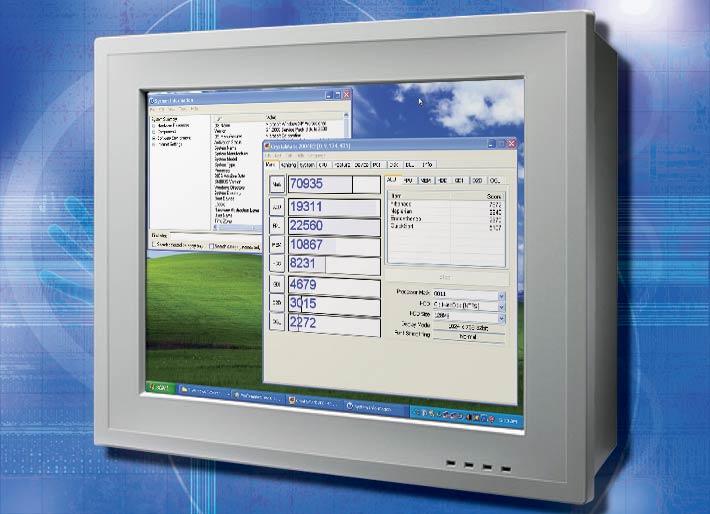
In this day and age of notebooks with 17-inch displays, the Advantech panel's 15-inch screen isn't very large, but the machine itself is quite substantial. Measuring 15.6 x 12.5 x 4.1 inches and sporting the compact, rational design common to all panel computers, the PPC-157T weighs over 13 pounds. The display uses the conventional 4:3 aspect ratio, has an analog 5-wire resistive touchscreen, and offers wide horizontal (160 degrees) and vertical (130 degrees) viewing angles for comfortable use. Viewability under all lighting conditions is augmented by anti-glare coating and strong 350-nit backlight (your average notebook has less than 200 nits).
Unlike mobile notebook and tablet computers that require a careful balance between performance, size, weight and power consumption, panel PCs are usually A/C-powered and have fewer size and weight constraints. The emphasis here is on quiet, reliable operation and the ability to run 24/7/365 with as little maintenance as possible. That means tried-and-true components and a minimal number of potential points-of-failure. With the PPC-157T, Advantech provides enough performance to handle almost any task, but not so much as to incur excessive cooling and potential reliability issues. That's done with a 2.16GHz Intel Core 2 Duo T7400 processor, a chip that's been around for four years and can be found in a number of mid-range notebooks and vertical market systems. Its 35 watt Thermal Design Power does require a small fan, but the thermal load is minimal.
Since panel PCs are often used as HMI (Human Machine Interface) systems, they must have sufficient onboard connectivity to interface with the machinery they are supposed to monitor and control. The PPC-157T provides both current systems and legacy systems support with four USB 2.0 ports, two RS232 serial ports, another that supports RS232/422/485, and a fourth that can be used for GPIO. There is also a VGA port for potential large/secondary screen applications, and dual Gigabit Ethernet jacks for communication with backend servers. Dual IEEE 1394 ports are optionally available for multimedia applications.
Application example for a machine like the PPC-157T
Advantech, a company that always illustrates the use of its products in rather informative marketing brochures and materials, illustrates one possible use for a panel computer such as the PPC-157T as follows:
In public service applications, there is a huge need for integrating various systems, applications, and platforms. Technology must be flexible, versatile, industrial-strength, user-friendly, and low-maintenance. Components must also adhere to standards and be able to meet a variety of local codes and requirements. All of this requires a combination of industrial quality hardware and global experience, both of which Advantech has.
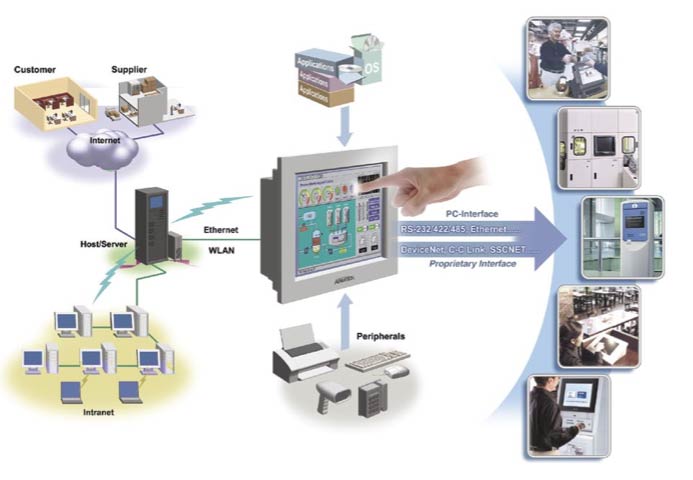
A panel such as the PPC-157T fills these requirements by being able to run a variety of operating systems, both standard and embedded; communicate with multiple networks with ist dual network connectivity; support legacy applications and peripheral hardware with extensive serial connectivity (RS232/422/485/TTL); support proprietary interfaces via internal PCI and PCIe expansion; support local peripherals via multiple USB ports; provide an easy user interface via a large touch screen; reduce complexity and maintenance with a minimum of physical controls or other things that can go wrong; provide scalable performance with a variety of processor classes; and offer attractive pricing.
OS and Performance
One of the facts of life in computing is that the operating system pretty much determines how much hardware you need. To run a current operating system such as Windows 7 at a reasonable speed, you need an amount of processing power that would have been considered in the supercomputer realm just a couple of decades ago. Yet, today it hardly seems enough to run a browser or some simple games. Panel PCs generally do not have this problem. Since most only run a single task or application, they may not need a general purpose operating system. While our test PPC-157T ran standard Windows XP on its internal hard disk, many customers may choose an embedded operating system with lower overhead and complexity instead.
In terms of performance, panel PCs generally offer as much as is needed for a task and no more. If a panel computer needs to communicate with a couple of networks and act as a control console for industrial equipment, it makes no sense to equip it with a bleeding edge processor and the latest graphics subsystem. In fact, it may run just fine with older processor hardware or a low power VIA or Atom setup. The PPC-157T with its 2.16GHz Intel Core 2 Duo processor is clearly targeted at more complex applications. To provide an idea of where the PPC-157T fits in in terms of overall performance, we ran our standard benchmark suites on it. Here's how the panel compares to other types of Advantech hardware we've tested in our lab:
|
PERFORMANCE COMPARISON PASSMARK
|
PPC-157T
|
ARK-3399
|
ARK-DS303
|
SOM-6760
|
|
Processor
|
Intel Core 2 Duo T7400
|
Intel Core Duo L2400
|
Intel Atom N270
|
Intel Atom Z530
|
|
Product type
|
Panel PC
|
Industrial PC
|
Digital Signage
|
COM-Micro module
|
|
Clock speed
|
2.16GHz
|
1.4GHz0
|
1.6GHz
|
1.6GHz
|
|
Thermal Design Power (TDP)
|
34.0 watts
|
15.0 watts
|
2.5 watts
|
2.3 watts
|
|
CPU Mark
|
1292.1
|
847.5
|
252.6
|
315.6
|
|
2D Graphics Mark
|
285.8
|
145.0
|
158.7
|
207.2
|
|
Memory Mark
|
552.3
|
264.9
|
227.7
|
191.6
|
|
Disk Mark
|
459.6
|
10.1
|
459.4
|
70.7
|
|
3D Graphics Mark
|
37.8
|
29.5
|
77.3
|
19.6
|
|
Overall PassMark
|
584.7
|
302.4
|
232.6
|
137.3
|
PERFORMANCE COMPARISON
CRYSTALMARK 2004R3
|
PPC-157T
|
ARK-3399
|
ARK-DS303
|
SOM-6761
|
|
ALU
|
19311
|
12971
|
5409
|
5376
|
|
FPU
|
22560
|
15353
|
4671
|
4667
|
|
MEM
|
10867
|
6407
|
4223
|
3667
|
|
HDD
|
8231
|
3631
|
8221
|
2702
|
|
GDI
|
4679
|
2403
|
2158
|
2427
|
|
D2D
|
3015
|
2444
|
2230
|
1009
|
|
OGL
|
2272
|
825
|
684
|
505
|
|
Overall CrystalMark
|
70935
|
44034
|
27596
|
20353
|
Note that benchmarks often generate weird results that do not seem to fit in. That's because they have a hard time generating directly comparable results over different processor architectures, operating systems, and storage technologies. However, overall summary results almost always provide a good idea of the relative performance of a product, and it's no different here. You can see that the Core 2 Duo-powered PPC-157T is significantly faster and more powerful than, say, an industrial PC such as the ARK-3399 with an older Core Duo processor, or boards and systems using the various versions of Intel Atom processors. Overall performance of the PPC-157T is, with the exception of lower graphics performance, roughly that of a powerful notebook computer. It's significantly faster than any current Intel Atom-based solution.
Enhanced Write Filter
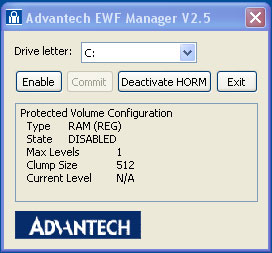 The Enhanced Write Filter was not actually installed on our test machine, but I'll include a brief section on it anyway as it'll be of interest to many potential users of the PPC-157T. Enhanced Write Filter, or EWF, is an interesting security feature supported by the Windows XP Embedded operating system. The Enhanced Write Filter was not actually installed on our test machine, but I'll include a brief section on it anyway as it'll be of interest to many potential users of the PPC-157T. Enhanced Write Filter, or EWF, is an interesting security feature supported by the Windows XP Embedded operating system.
What the Enhanced Write Filter does is provide the ability to write-protect a run-time image. It does that by redirecting write operations to another storage location and totally write-protects the run-time image, thus preventing any damage that might be caused by an unexpected power failure, vibration or even a virus attack.
Taking full advantage of EWF technology requires some studying and proper configuration of a system. To learn more about this particular feature of XP Embedded, read the Enhanced Write Filter section at the Microsoft Embedded Developer Center.
Straightforward design
Panel computers are, for the most part, utilitarian tools for industrial jobs. As such, the emphasis is on simplicity and functionality rather than glossy glitz and bling. The picture below shows the PPC-157T from the front and all four sides. The front bezel and housing are the same beige plastic that graced generations of PCs (and quite a few early Macs). The chassis inside is all steel. There are cooling slots and a few other openings as this is, with the exception of the IP65-protected front bezel, not a sealed system.
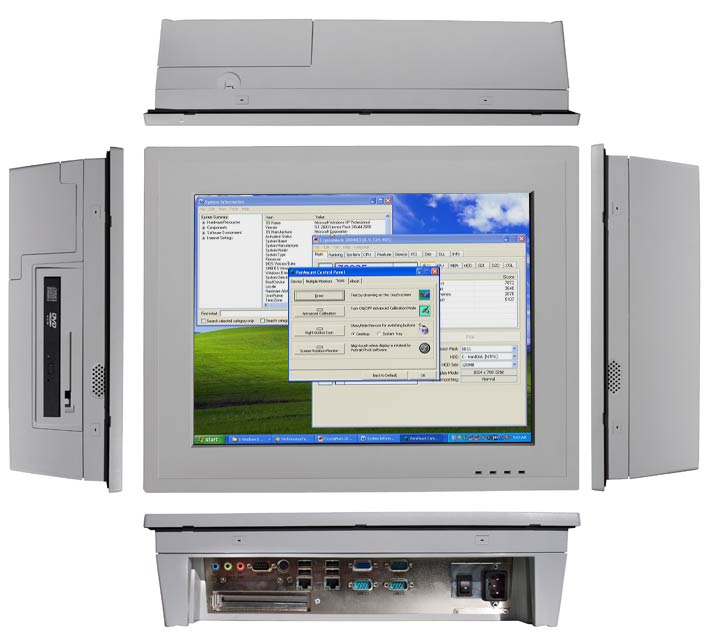
Looking at the four sides, you can see that all connectivity is concentrated along the bottom side, facing down. The sole exception is the optional optical drive on the left, and that is also where you'd find access to the unit's Compact Flash slot underneath the hard drive cover.
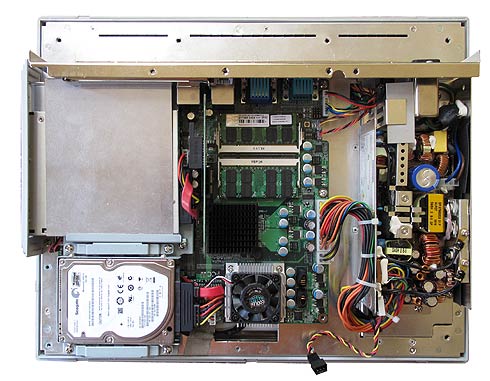 The picture on the right shows the backside of the PPC-157T with its plastic back cover removed. You can see that, this being a fairly large and deep system, Advantech had the luxury of building the insides of this Panel PC spaceously, almost like a compact desktop PC. Essentially, what you have here is a standard 8 x 9-inch motherboard with full onboard desktop PC-style connectivity. The picture on the right shows the backside of the PPC-157T with its plastic back cover removed. You can see that, this being a fairly large and deep system, Advantech had the luxury of building the insides of this Panel PC spaceously, almost like a compact desktop PC. Essentially, what you have here is a standard 8 x 9-inch motherboard with full onboard desktop PC-style connectivity.
On the right side you can see the open power supply, which means that the machine only needs a power cord, and not a bulky power brick. To the left of the power supply is the PCM-8200 mother board. In the bottom center sits the Intel Core 2 Duo T7400 processor. Thanks to its modest (for a stationary computer) 34 watt thermal design power it only needs a minimal cooling sink and a tiny, almost silent fan.
Above the processor and chipset, memory is mounted in two SO-DIMM slots. In our review unit, each contained a DDR2 667MHz 2GB module, for a total of 4GB of RAM.
In terms of expansion, there is a PCI-e slot on the motherboard that can either be used directly, or via a riser board. The slot can also be used for an optional full PCI connector. The motherboard also has a Mini PCI and a Mini PCI-e socket, both hidden underneath the mass storage subframe to the left that holds the disk and optical drive. Also underneath the assembly is a CF Card Type II slot, presumably used for applications where the OS runs off Flash.
Touch panel
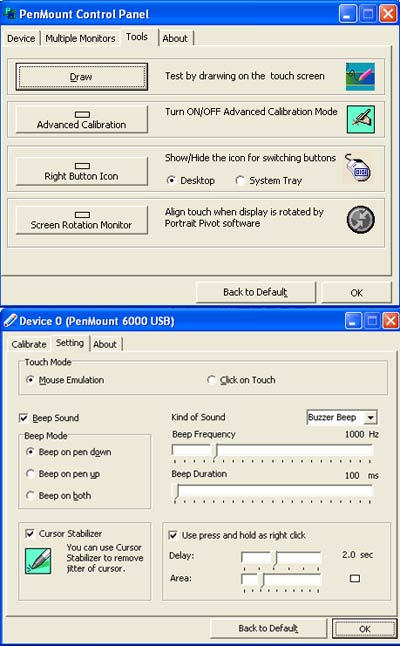 Our Advantech PPC-157T had the optional 5-wire analog resistive touchscreen with a serial interface. It uses the PenMount 6000 Controller Chipset. The touch screen itself is a heavy-duty unit that is rated at ten million depressions. The resistive touch screen can be operated either with any stylus or with a finger. Like the touch screens used in other Advantech products, this one is very smudge-resistant, a quality that's much appreciated in daily use. Our Advantech PPC-157T had the optional 5-wire analog resistive touchscreen with a serial interface. It uses the PenMount 6000 Controller Chipset. The touch screen itself is a heavy-duty unit that is rated at ten million depressions. The resistive touch screen can be operated either with any stylus or with a finger. Like the touch screens used in other Advantech products, this one is very smudge-resistant, a quality that's much appreciated in daily use.
The unit comes with a PenMount Control Panel that let's you calibrate the touchscreen using 4, 9, 16, or 25 points, with 25 points offering maximum accuracy. A "Draw" mode provides digitizer statistics and can be used for debugging. An option menu lets you set the operation mode either to stream mode or point mode.
The control panel has a special screen for edge compensation. Edge compensation can be very important for precise calibration. With touch screens and digitizers it can be difficult to touch or select items at the edge of the panel, especially when the display runs all the way to the kind of thick protective bezel most rugged panels have. The 157T's panel allows you to precisely define edge compensation for all four sides, i.e., set it so the cursor thinks the edge is either farther away or closer in. Precise configuration can make for optimal usability and responsiveness in touch applications.
In the panel's Setting menu you can configure touch mode to work either in mouse emulation or to simply issue a click on touch. You can also enable press-and-hold for right mouse clicks and fine-tune right mouseclick operation, setting both the delay and the size of the click area.
You can also enable a beep sound to occur on pen down or pen up (or both), and even set its frequency and duration. This may sound strange, but in noisy shop floor operation, having auditory feedback to confirm a touch operation may come in handy.
In applications that use multiple monitors, the PenMount Control panel let's you configure multiple monitor support and map the touch screens.
Why is all of this important? Because having the proper tools to precisely configure a touch screen for an application can make or break its utility and usability. And with touch screen vendors now adding multi-touch/multi-finger operation, this will only become more important.
If resistive touch is not suitable for an application, the PPC-157T can also be shipped with a capacitive or a surface acoustic wave (SAW) touchscreen. This adds even more flexibility to an already highly versatile and configurable system.
Power
As a panel PC with ready access to external power, the PPC-157T does not have a battery and runs on external A/C power instead. Its integrated power supply can handle 10 to 240 Volt input at 50 or 60Hz, and provides a maximum of 150 watt output.
Storage and expansion
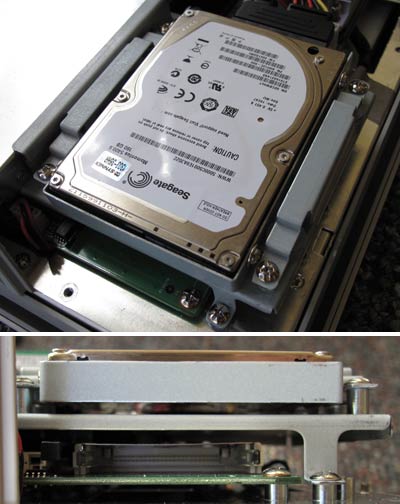 As a full-function panel PC, the Advantech PPC-157T has an internal hard disk bay that can accommodate standard 2.5-inch disks. As a full-function panel PC, the Advantech PPC-157T has an internal hard disk bay that can accommodate standard 2.5-inch disks.
Our review machine came with a 160GB Seagate Momentus ST9160314AS with a speedy 3Gb/second SATA interface. It's spinning at 5,400 RPM and is quite power-efficient, using about 1.4 watts idling and about 1.8 watts operating. The disk's operating temperature range is 32 to 140 degrees Fahrenheit and it can handle operating shocks up to 350Gs.
As if the disk's inherent shock-resistance were not impressive enough, the disk itself is mounted in a floating metal case that is then suspended via soft silicone bushings in a very cleverly designed subframe caddy, giving it excellent protection against shock and vibration.
Underneath the hard disk assembly sits a Compact Flash Type II slot, mounted directly onto the motherboard (see bottom image in the picture to the right). In units with hard disks, the CF Card slot is not used and can presumably available for other purposes. However, systems configured to run Windows XP Embedded (or one of the newer Embedded Standard versions) may forego rotating media and run the OS off CF Card Flash.
Depending on the application, the PPC-157T can be configured with an optional optical disc drive kit that may contain a SATA DVD writer.
Ruggedness
As a panel PC, the Advantech PPC-157T addresses ruggedness in a different way from a mobile computer. Since it will be installed in a panel or other stationary setting, it won't be dropped very often, if ever. And since it is most likely used indoors, it won't get rained on. However, it is expected to run reliably 24/7 in factory settings where temperature, vibration, and exposure to water still can be issues.
As a result, the PPC-157T is sturdy and very well built. The industrial plastic bezel and housing won't easily scratch or break. When mounted in a panel, a neoprene gasket behind the bezel lip effectively seals the computer. So while the housing itself has ventilation slots and standard connectors, from the front the system carries the equivalent of IP65 sealing. This means that a panel with the PPC-157T installed could be hosed down and not incur any damage.
In terms of operating temperature, panels are not generally installed freezers, and so the device is designed to operate within a range of 32 to 122 degrees Fahrenheit, well beyond the range where human operators can comfortably work.
Advantech does provide shock test figures and certifies the panel to 10G peak acceleration for a duration of 11 msec.
Bottom line
The Advantech PPC-157T is a versatile industrial panel computer from an experienced Taiwanese embedded and industrial systems manufacturer with a worldwide presence. Our test machine came with a powerful 2.16GHz Intel Core 2 Duo processor, making it suitable even for advanced applications.
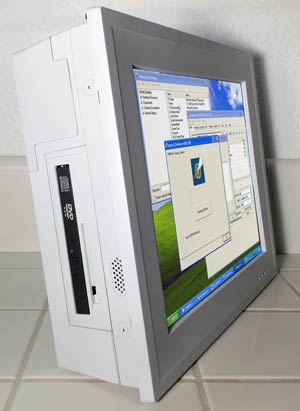 The PPC-157T can be configured either as an embedded device running one of the Windows Embedded operating systems on disk or Compact Flash, or as a full Windows 7 or XP machine using the internal SATA hard disk. The unit comes with up to a 4GB of DDR2 RAM and can also accommodate an optical drive. The rather powerful processor provides very good performance but does need a (small) fan. When mounted in a panel, the PPC-157T's front bezel is sealed to IP65 specifications. The unit is designed to handle the abuse (shock, temperature, humidity, etc.) likely encountered in an industrial environment. The PPC-157T can be configured either as an embedded device running one of the Windows Embedded operating systems on disk or Compact Flash, or as a full Windows 7 or XP machine using the internal SATA hard disk. The unit comes with up to a 4GB of DDR2 RAM and can also accommodate an optical drive. The rather powerful processor provides very good performance but does need a (small) fan. When mounted in a panel, the PPC-157T's front bezel is sealed to IP65 specifications. The unit is designed to handle the abuse (shock, temperature, humidity, etc.) likely encountered in an industrial environment.
Advantech offers panel computers with a wide variety of screen sizes and touchscreen technologies. The 157T with its large 15-inch display with 4:3 aspect ratio is designed to fit into tight spaces. The display has excellent anti-glare properties and is almost totally immune to smudges and fingerprint. Our test unit had the optional resistive touch screen that was very responsive and highly configurable for optimal use with both a stylus or fingers. Capacitive and Surface Acoustic Wave touchscreens are also available.
The PPC157T offers excellent onboard connectivity for use with a variety of current or legacy devices and peripherals. You get four external USB 2.0 USB ports, four RS232 and RS232/422/485/TTL serial ports, video for an external monitor, and dual LAN. There is also CF Card slot (used for the OS in non-HD systems) and internal PCI/mini-PCI/mini-PCIe slots that can be used for additional expansion.
The PPC-157T is a cleanly designed, powerful panel computer that combines versatility, ruggedness, easy customization and maintenance, and very good performance. It can be configured for a large variety of applications in all kinds of manufacturing and industrial settings, with application in numerous other settings as well.
-- Conrad H. Blickenstorfer
Advantech PPC-157T Specs:
| Type |
All-in-One Rugged panel computer
|
| OS |
Windows 7, Windows XP, Windows XP Embedded
|
| Processor |
Intel Core 2 Duo T7400, 4MB L2 cache, 667MHz FSB
|
| Clock speed |
2.16Hz
|
| Thermal Design Power |
34 watts
|
| Chipset |
Intel 945GME + ICH7M
|
| Memory |
Up to 4GB DDR2 667MHz SDRAM in two 200-pin SO-DIMM sockets |
| Display |
15" XGA (1024 x 768) color TFT with 160/130 degrees viewing angle, anti-glare coating, and 350 nit backlight
|
| Digitizer |
Optional 5-wire analog resistive touch screen with PenMount 6000 Controller and USB interface |
| Keyboard |
Optional external USB |
| Storage |
HDD bay for shock-mounted 2.5-inch SATA/300 disk (test machine had 160GB Seagate Momentus); CF-based Flash
|
| Optional storage |
Optional optical drive bay for SATA DVD/CD-RW or SATA DVD+/-RW drive
|
| Expansion slots |
1 internal PCI-e, 1 Mini-PCI, 1 Mini-PCIe, 1 CF Card Type 2; optional PCI
|
| Housing |
Plastic bezel and enclosure, metal case, with 75 and 100mm VESA-standard mounting |
| Size (inches) |
15.6 x 12.5 x 4.1 inches |
| Weight |
13.2 pounds as tested
|
| Operating temperature |
32 to 122 degree Fahrenheit |
| Ingress protection |
IP65 (front panel only) |
| Shock |
10 G peak acceleration (11 msec duration) |
| Vibration |
unknown |
| EMC |
BSMI, CE, FCC Class B, CCC |
| Safety |
CB, CE, UL |
| Humidity |
10-95% non-condensing |
| Power |
100-240 Volt DC |
| Interface |
External: 4 USB 2.0, 1 RS-232/422/485, 2 RS-232, 1 RS-232/GPIO (8 channels, TTL level), 2 x RJ45 LAN (10/100/100), audio in/out/mic, VGA, PS/2; optional: 2 x IEEE 1394 |
| Wireless options |
Flexible expansion capability via Mini-PCI or Mini-PCIe
|
| Price |
Inquire |
| Web |
Advantech www.advantech.com.tw |
| Product page |
Advantech |
(copyright 2010 RuggedPCReview.com)
Advantech Corporation
38 Tesla, Suite 100
Irvine, CA 92618
Toll Free: 1-800-866-6008
Ph: 949-789-7178
Fax: 949-789-7179
ECGInfo@advantech.com
www.advantech.com
Advantech Co. Ltd.
No.1, Alley 20, Lane 26, Rueiguang Road
Neihu District, Taipei Taiwan 114, R.O.C.
Tel: 886-2-2792-7818
Fax: 886-2-2794-7301
www.advantech.com
|



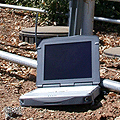

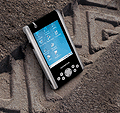
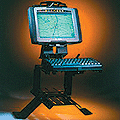







 The Enhanced Write Filter was not actually installed on our test machine, but I'll include a brief section on it anyway as it'll be of interest to many potential users of the PPC-157T. Enhanced Write Filter, or EWF, is an interesting security feature supported by the Windows XP Embedded operating system.
The Enhanced Write Filter was not actually installed on our test machine, but I'll include a brief section on it anyway as it'll be of interest to many potential users of the PPC-157T. Enhanced Write Filter, or EWF, is an interesting security feature supported by the Windows XP Embedded operating system.

 The picture on the right shows the backside of the PPC-157T with its plastic back cover removed. You can see that, this being a fairly large and deep system, Advantech had the luxury of building the insides of this Panel PC spaceously, almost like a compact desktop PC. Essentially, what you have here is a standard 8 x 9-inch motherboard with full onboard desktop PC-style connectivity.
The picture on the right shows the backside of the PPC-157T with its plastic back cover removed. You can see that, this being a fairly large and deep system, Advantech had the luxury of building the insides of this Panel PC spaceously, almost like a compact desktop PC. Essentially, what you have here is a standard 8 x 9-inch motherboard with full onboard desktop PC-style connectivity.
 Our Advantech PPC-157T had the optional 5-wire analog resistive touchscreen with a serial interface. It uses the PenMount 6000 Controller Chipset. The touch screen itself is a heavy-duty unit that is rated at ten million depressions. The resistive touch screen can be operated either with any stylus or with a finger. Like the touch screens used in other Advantech products, this one is very smudge-resistant, a quality that's much appreciated in daily use.
Our Advantech PPC-157T had the optional 5-wire analog resistive touchscreen with a serial interface. It uses the PenMount 6000 Controller Chipset. The touch screen itself is a heavy-duty unit that is rated at ten million depressions. The resistive touch screen can be operated either with any stylus or with a finger. Like the touch screens used in other Advantech products, this one is very smudge-resistant, a quality that's much appreciated in daily use.
 As a full-function panel PC, the Advantech PPC-157T has an internal hard disk bay that can accommodate standard 2.5-inch disks.
As a full-function panel PC, the Advantech PPC-157T has an internal hard disk bay that can accommodate standard 2.5-inch disks.
 The PPC-157T can be configured either as an embedded device running one of the Windows Embedded operating systems on disk or Compact Flash, or as a full Windows 7 or XP machine using the internal SATA hard disk. The unit comes with up to a 4GB of DDR2 RAM and can also accommodate an optical drive. The rather powerful processor provides very good performance but does need a (small) fan. When mounted in a panel, the PPC-157T's front bezel is sealed to IP65 specifications. The unit is designed to handle the abuse (shock, temperature, humidity, etc.) likely encountered in an industrial environment.
The PPC-157T can be configured either as an embedded device running one of the Windows Embedded operating systems on disk or Compact Flash, or as a full Windows 7 or XP machine using the internal SATA hard disk. The unit comes with up to a 4GB of DDR2 RAM and can also accommodate an optical drive. The rather powerful processor provides very good performance but does need a (small) fan. When mounted in a panel, the PPC-157T's front bezel is sealed to IP65 specifications. The unit is designed to handle the abuse (shock, temperature, humidity, etc.) likely encountered in an industrial environment.